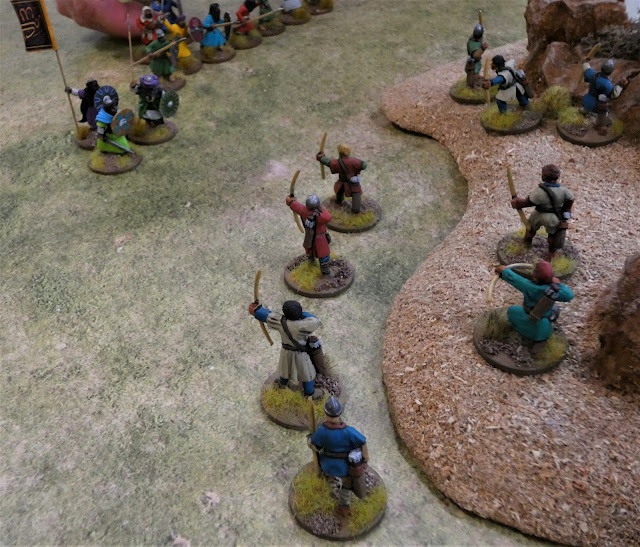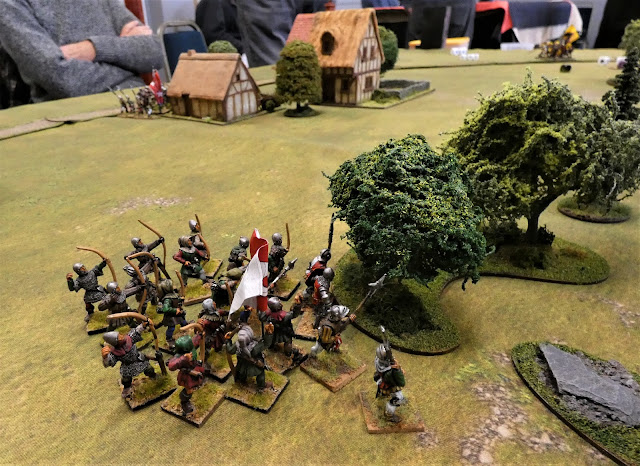The game was played using the new Lion Rampant second edition rules together with The Crusader States supplement. It is based on the events described in scenario 1 on page 93 of the supplement, but instead of the game covering the last stand and massacre of the Genoese infantry by the Turks we take up the narrative at the point where Bohemond of Taranto intercepts the Turkish force responsible for the massacre to exact his revenge.
Background
A Genoese fleet lands at the harbour of St Symeon about ten miles from Antioch. Bohemond of Taranto meets the fleet and persuades a force of Genoese to accompany him to Antioch to assist in the fight against the Turks. On the road to Antioch Bohemond and the Genoese are attacked by a larger Turkish force. Bohemond and his men are mounted as are some of the Genoese who ride and escape making their way to Antioch.
The remaining Genoese foot put up a brave defence, but are so out numbered they are killed to a man.
Bohemond returns from Antioch with reinforcements and intercepts the Turkish force and here begins our game:
Victory conditions
Turkish players
One Victory Point for each unit (even those having taken casualties) they manage to exit from the opposite end of the board.
Frankish players
One Victory Point for each unit they rout or wipe out.
Special Rules
Failed activations do not pass play to the opposite side. Activations continue until all units have had attempted activation. The warlord can give a re-role to any unit within 12” of his figure once per turn. Due to the number of units on the board the 3” distance rule for friendly troops is reduced to 2”.
As the Turks are the defender they set up first on the southern edge of the board and the Franks on the north end. The Turks deploy a unit of archers on their left flank with two units of light infantry in the centre supported by a unit of elite foot and a unit of heavy cavalry with bows who are blood thirsty (all sixes rolled by them in a melee count as two hits). On their right flank are two more units of blood thirsty mounted bows and another unit of elite foot with the warlord.
The Franks set up next putting two units of Genoese heavy cavalry on their right flank supported by two groups of skirmishers taking cover in rough terrain with a unit of heavy foot behind them. Bohemond is in the centre with two units of elite foot who are effectively blocking the road. On the Frankish left flank are two units of mounted blood thirsty knights (elite cavalry) supported by a unit of crossbows.
The Franks quickly get their mounted knights moving up on their left flank and the crossbows move into rough terrain to make use of what cover they can in support of the knights. Bohemond and the two units of elite foot maintain their position blocking the road. On the Frankish right flank the Genoese heavy cavalry remain static seemingly content to wait their moment and watch the battle unfold.
The Turkish force are quick to respond to the threat of the Frankish knights and the two units of mounted bows surge forward to intercept them while a swift unit of their light infantry move towards the Frankish crossbows supported by the warlord and his elite infantry. The Turkish mounted bows fire on the Frankish knights and have some success but the knights’ resolve remains firm and they charge home inflicting casualties on the mounted Turks who pull back staying within bow range but out of charge range of the knights.
In the centre a unit of Turkish light infantry moves over to support the Turkish archers who have taken cover behind rocks on their left flank and have started to target the Genoese heavy cavalry. Because of the distance they are shooting, their arrows have no real effect on the Genoese who remain passively looking on. In fact the whole Frankish right flank remains static while the battle continues on their left flank where the first unit of knights has been reduced by the constant rain of arrows from the Turkish mounted bows who eventually charge them and wipe them out. Seeing this the second unit of Frankish knights hesitates.
All is not going so well for the Turkish light infantry moving in on the Frankish crossbows who deliver devastating volleys and reduce their number to half in a very short time. Buoyed up by the proximity of their warlord, they stand their ground. However when a third volley hits them they rout and quit the battlefield. Soon after the unit of mounted Turks are also hit by the crossbows and die to a man. Things are not looking good for the Turkish side.
It is at this point, that scenting blood, the Genoese heavy cavalry make their move and ride towards a unit of Turkish light foot who are braced in a shieldwall next to their archers who are taking cover in the rocks. The first unit of cavalry hits the shield wall causing and receiving casualties. The shieldwall stands firm and now the Genoese cavalry are much closer, the Turkish archers fire on them removing one unit from the field of battle and causing the second to become battered. The Frankish skirmishers in the rocks on the Frankish right flank see the unite of Turkish elite foot containing the warlord coming towards them and they target the unit eventually reducing it by half, but with the Turkish warlord present, the units courage holds and they enter the rough terrain attacking the skirmishers killing some and driving both units back and out of their cover.
Bohemond now realises that his right flank is crumbling. The heavy infantry move forward to intercept the Turks and Bohemond and his elite foot move forward to try to intercept a unit of Turkish mounted bows who manage to ride around him and make their escape off of the board edge.
With their left flank now wide open, the Turkish force uses a unit of their mounted bows on their right flank to fight a delaying action against the remaining unit of Frankish knights and elite infantry, while the rest of their force make good their escape on their left flank.
Conclusion
The Turkish force took substantial casualties, however the Franks only succeeded in killing and routing two of their units. With such a high casualty toll, in a usual game the Turks would have simply fled the field as their numbers were so depleted. In this scenario however, they did not have that luxury, as simply turning back would have seen them hunted down to receive the same treatment as they gave the Genoese infantry.
The Turkish force managed to get five units off of the board and so they won 5 Victory points to 2.
AAR courtesy of Mike C.








































